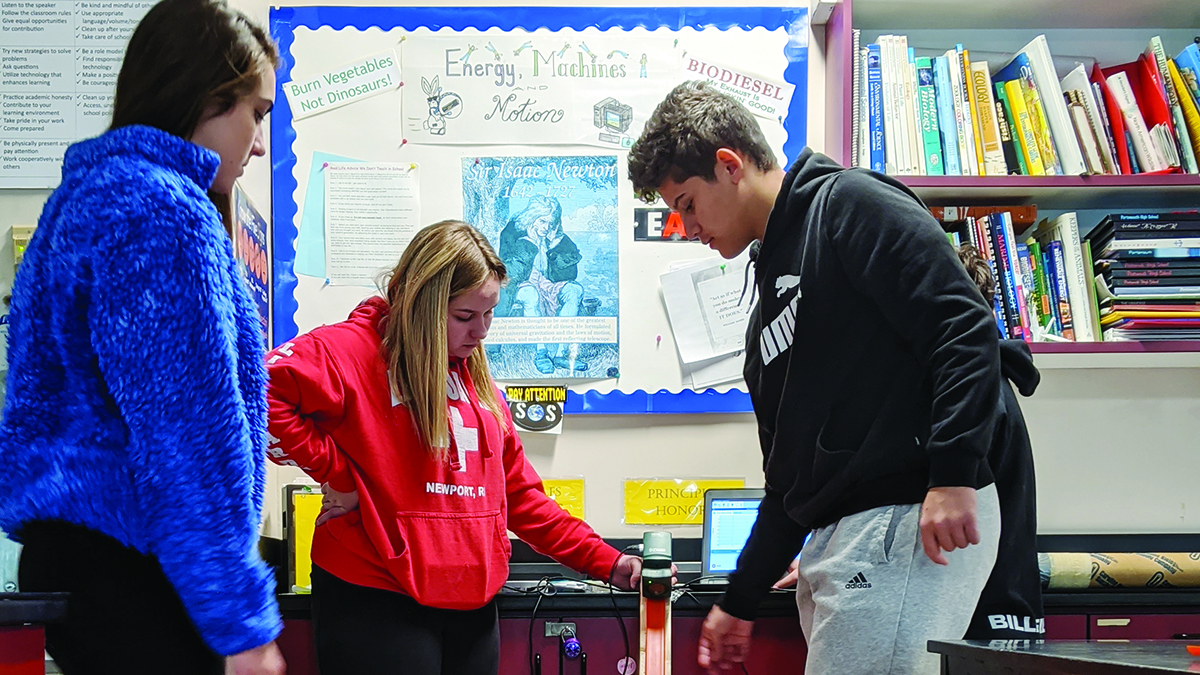feature
Accessible Physics for All
Providing equity of access for high school physics with extended experimentation and data analysis
When Dan Damelin was a high school chemistry teacher, he always asked for the lower-level science classes with a high portion of students on individualized education plans (IEPs). He recalls, “They loved the hands-on activities and the technology opportunities I knew I wanted to use in the classroom.” He felt these students could do as well as everyone else with the right approach and technological supports, and wanted to explore how an inquiry approach using simulations for student-centered discovery could help close the learning gap.
Today, Damelin directs a National Science Foundation-funded project at the Concord Consortium that works to bring independent experimentation and data analysis using sensors and free software into high school science classrooms. The InquirySpace project recently had an unusual opportunity to work in one classroom that practices full inclusion for ninth grade physics. Nearly half of the students (9 of 20) were on IEPs for a variety of learning disabilities, including dyslexia, autism, and other health-related impairments. Two additional students also faced learning challenges but were not on individualized plans. The reading level of these students ranged from second grade to seventh grade. The class was co-taught by both a certified physics teacher and a special education specialist, also coauthor of this article, Michelle Murtha.
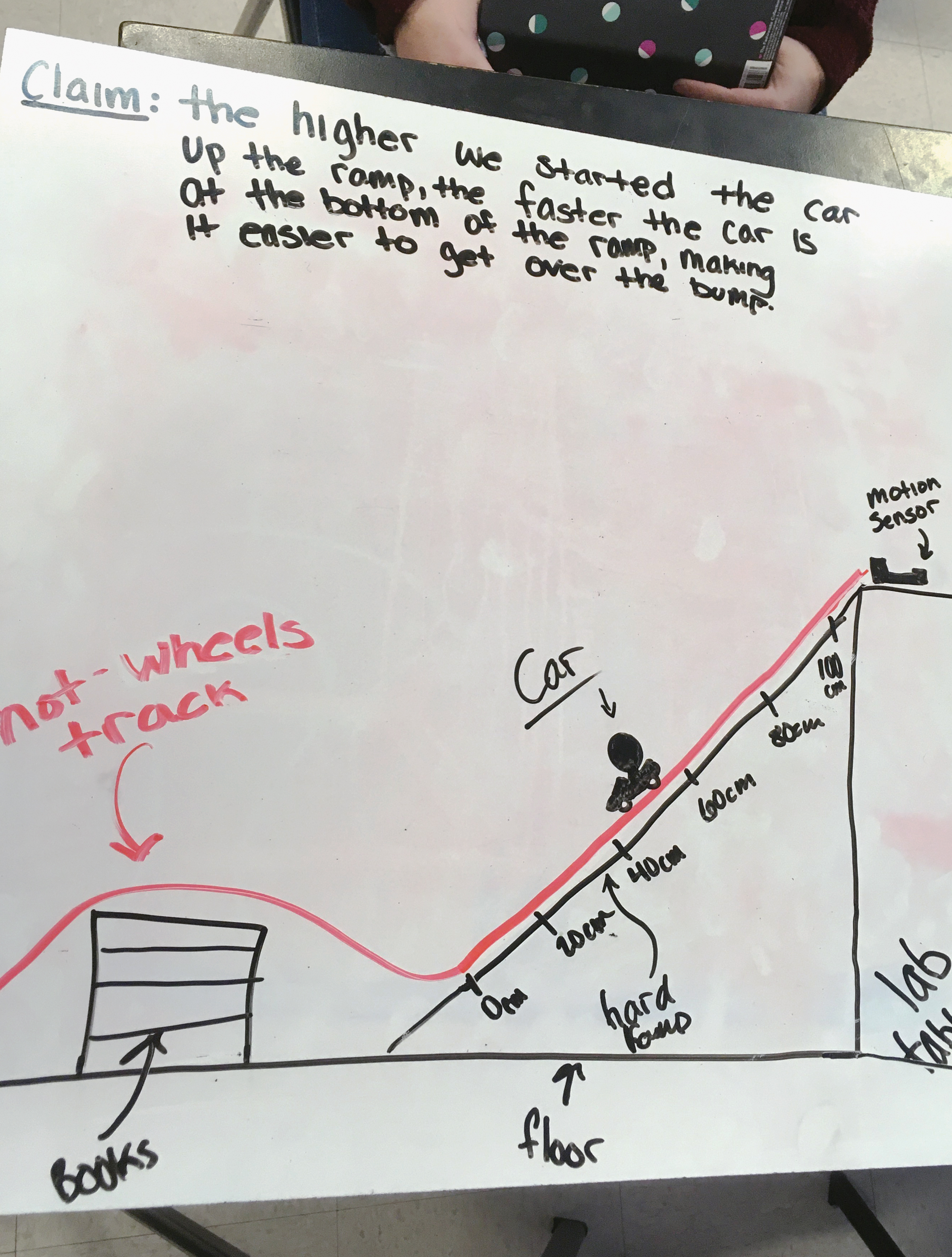
Whiteboard of student setup.
NGSS: Accessible to all
The Next Generation Science Standards (NGGS Lead States 2013) propose equal access for science (Schwartz, Passmore, and Reiser 2017). Murtha adopts many recommendations from the Universal Design for Learning framework developed by CAST (see “On the web”) to improve and optimize teaching and learning for all students based on scientific insights into how humans learn. Everyday practical examples include using “dyslexia-friendly” Arial or similar sans-serif fonts for text resources; providing free text-to-speech and translation tools, such as browser extensions that accommodate many reading challenges; and using the free online “Text Compactor” tool to provide summaries of classroom resources (see “On the web”).
She assigns groups heterogeneously, pairing her neediest students with the most patient and her lowest with the most capable. Student groups collaborate in a shared document with a notetaker, ensuring that each student has access to good notes and that anyone can add details. Murtha brought with her a rich background supporting learners with accommodations to improve equity of access. Working with our research team, she discovered that, although she already had high expectations of her students, properly-applied techniques and technologies would allow her to expect even more of them.
One goal of the InquirySpace project is to show both teachers and students how to integrate experimental design and analysis at the secondary level for physics, biology, and chemistry. Three investigations in each subject area foster NGSS science practices, particularly Asking Questions and Defining Problems, Planning and Carrying Out Investigations, Analyzing and Interpreting Data, Using Mathematics and Computational Thinking, and Constructing Explanations (NGSS Lead States 2013).
The first investigation introduces experimental setups, data collection, and the basics of data analysis using the free Common Online Data Analysis Platform, or CODAP (see “On the web”). The second investigation emphasizes the importance of careful experimental design, a control-of-variables approach, and more advanced data organization and analysis techniques. Finally, learners apply these skills in student-led explorations of phenomena. For more information on the project, see “On the web.”
According to Murtha, the hands-on, inquiry-based activities incorporating science practices for experimental research are ideal for these students, especially when supported with additional scaffolds for reading, learning, using science terminology, managing frustration, keeping focused, engaging in collaborative work, and identifying entry points for productive science talk with peers.
Supporting learner engagement
Murtha incorporates numerous strategies for keeping everyone involved. Before class, she prepares paper copies of directions that will be posted on screen since some of her students have difficulty orienting when they are required to look up and then back down to proceed. These copies allow students to write on their handouts as they navigate the multiple steps the class is following. She also laminates checklists for tracking activities as they occur during hands-on labs. The students with IEPs use these to follow the action, stay engaged, and mark tasks completed as their group progresses. She also keeps an eye out for vocabulary in the curriculum that she can simplify (e.g., changing “rescale” to “resize”) and provides even more graphical instructions for her lowest readers (see Online Connections, Kickball Challenge Directions).
As the co-teacher leads a whole class discussion, she stands at the whiteboard, ready to provide summary graphics and text to support learning from the conversation. She reminds students to add new terms to their vocabulary notebooks as words emerge in class. Murtha notes, “JP [her co-teacher] goes pretty fast.”
Supporting social interaction for learning
Murtha projects a blank version of a lab worksheet to record contributions from different groups during whole group discussion. She adds each student’s name to their contribution and encourages learners who are on the autism spectrum and others who have challenges with social interactions to ask questions or discuss responses later, thus providing her students with topics for productive talk (Michaels and O’Connor 2012) with peers, as well as reminders of who to ask. In some cases, the most valuable opportunity is the following day. She explains, “Sometimes they need 24 hours to digest. For homework they review their work and are able to process and come back with better questions. For example, what did Phoebe mean by ‘changing the mass’?”
Navigating CODAP for data analysis
Before the class started working with the CODAP data analysis program, Murtha familiarized her students with using online tools for learning. They needed basic support in understanding the computer and its features as well as for navigating the software. Because her students are easily frustrated, she also worked individually with them during class. She created a customized graphical manual for learning CODAP to provide access to readers at all levels (See Online Connections, CODAP Toolbar Reference Sheet). However, by the final investigation even her lowest-performing student no longer needed the manual and was taking the lead in setting up graphs and analyzing motion sensor data for his group.
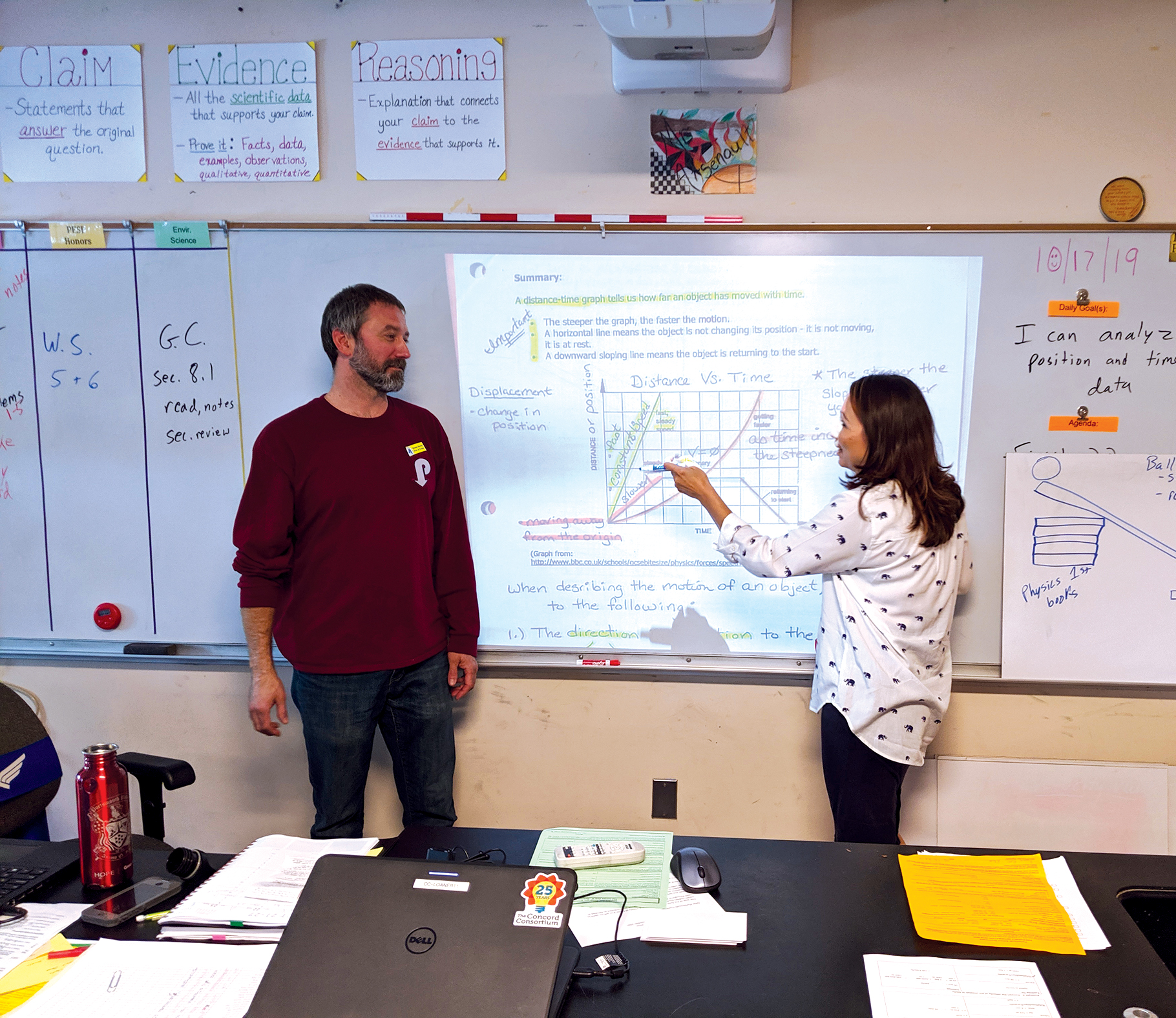
Co-teachers JP Arsenault and Michelle Murtha work together in front of the class.
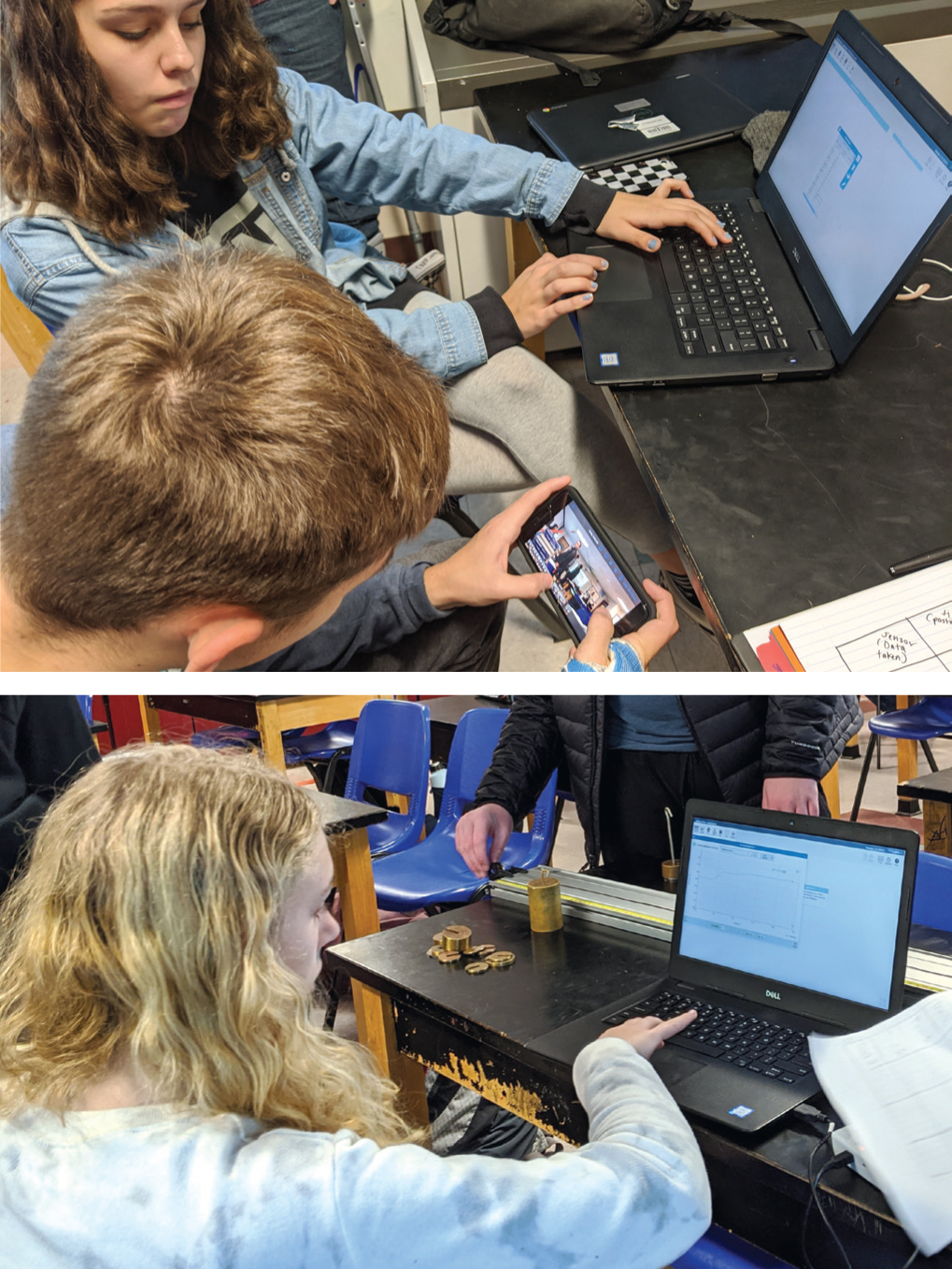
Upper: Slow motion video taken on student phone for independent investigation. Lower: Half-Atwood setup for independent investigation.
Success
To our mutual delight, Murtha’s students outperformed expectations when provided these opportunities. One in particular needed extra support learning how to manipulate CODAP. Murtha talked her through the steps while the student navigated the keyboard. Later, the student was showing others how to create graphs, add columns, and calculate velocities. Murtha beams, “She was teaching other students. It’s a bit of a change for her to be showing others how to make the graphs, setting the position vs. time.”
In one activity, students used motion sensors to capture data on toy cars rolling down plastic ramps. Murtha stayed in the background, allowing students to problem solve: It was interesting to see the struggles in the class around placing the sensor. JP was talking about where to place it. Some kids said at the top of the ramp, some at the bottom, or all the way at the back. When the groups compared graphs, if you put it all the way in the back, you get negative velocity. If it’s at the top of the ramp, you aren’t looking at the velocity, you’re looking at slope. If it’s on the bottom, it’s velocity. It was a good discussion of how you can get a negative velocity. They remembered it from the first time they made graphs by physically walking back and forth with the sensors to create a graph. I just listened. They are so used to the teacher giving them the answer, I wanted them to figure this out for themselves.
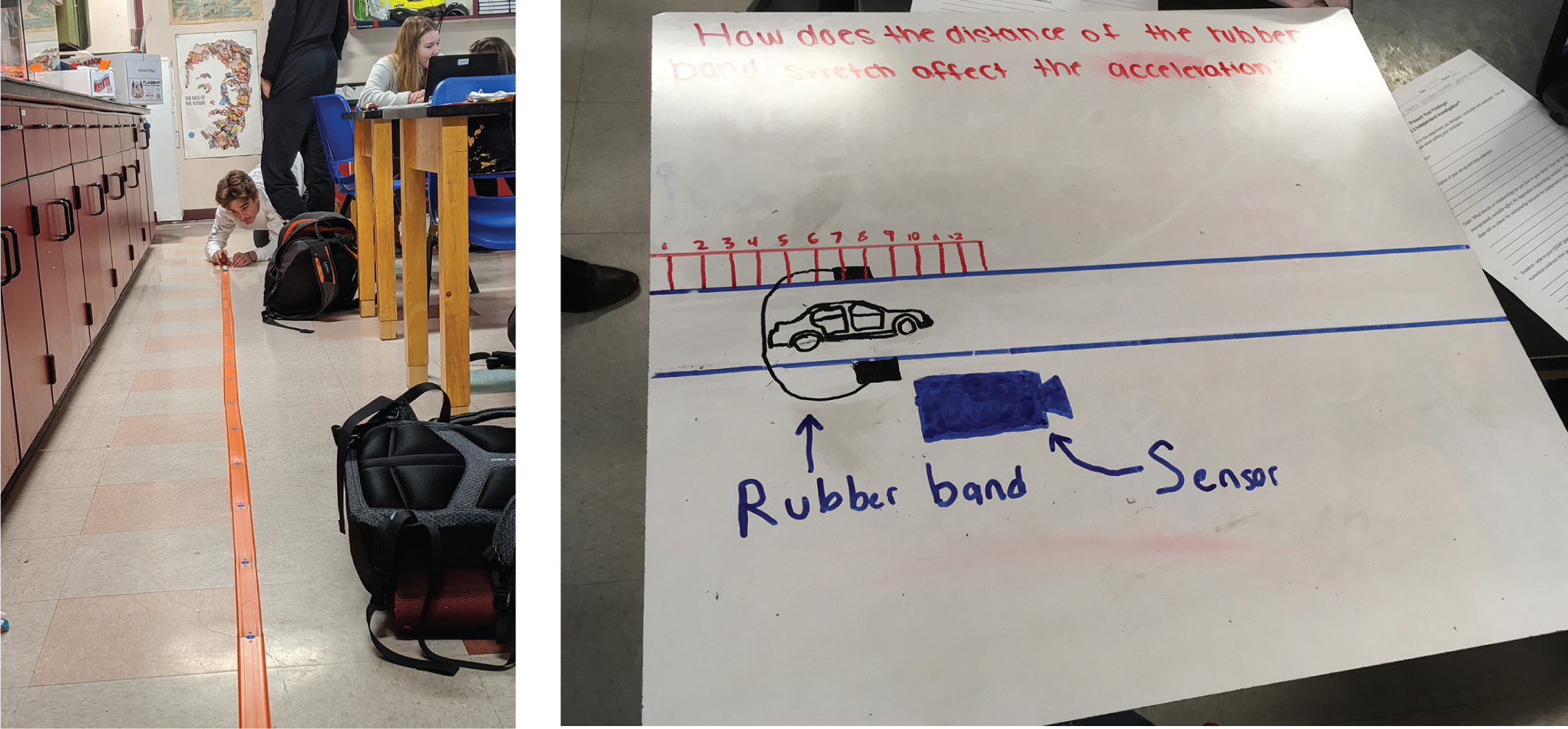
Sling shot setup with whiteboard.
During the final investigation, Murtha noted: I wanted to see how would they do if I didn’t offer reference sheets since they have been working on the computer for a while now. They knew exactly what to do in CODAP: add a column, make graphs, discard data, edit a formula, and so on. Even my lowest student was able to do a lot of it, even though we still had to help him. We reminded him about some things, but he remembered that time goes on the × axis and that it was the independent variable. I also wanted to see if they could do without the checklist. And they did!
Murtha described one student on an IEP and her contributions in the final investigation when the group was troubleshooting their motion sensor: They finally realized they didn’t push the connector in all the way. She loves working with the sensors and looking at the graph and selecting pieces of the graph to save (See Online Connections, Progress Over Time). Because it was scaffolded from the beginning, she doesn’t need anything from me anymore.
Following independent experiments, groups were expected to present their findings. To guide their presentations, Murtha created a modified worksheet (See Online Connections, Present Your Findings). Students were then asked to fill out a Claim-Evidence-Reasoning (CER) Conclusion Graphic Organizer designed to complete their project (See Online Connections, Conclusion Graphic Organizer). In collaboration with colleagues, she also created a CER conclusion rubric that is now adopted more widely by the science department at her high school (See Online Connections, Rubric). As so often happens with supports created for some, they are useful to many others as well. Additionally, she devised CER sentence starters (See Online Connections, CER Sentence Starters) and created a version of the document similar to elementary school double-lined writing paper complete with colored bars and dashed midlines for her lowest performers (See Online Connections, Elementary Graphic Organizer).
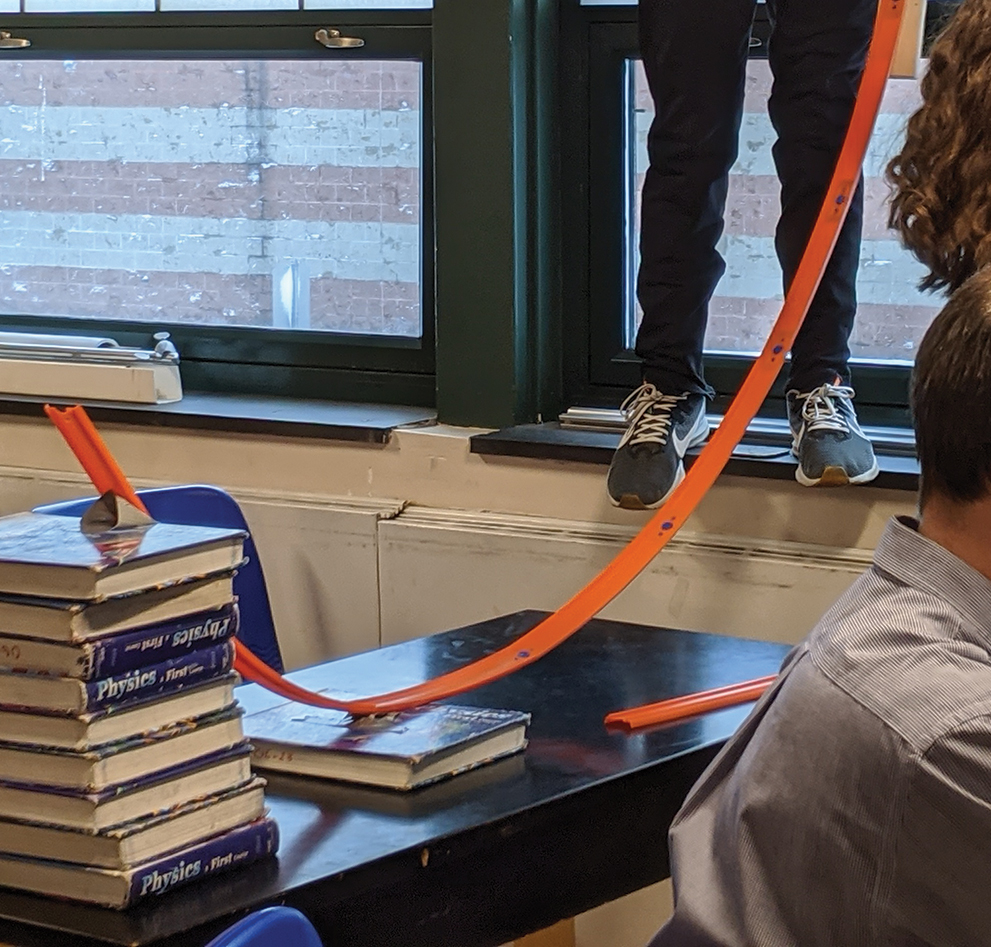
Setup of car jumping off the end of a ramp.
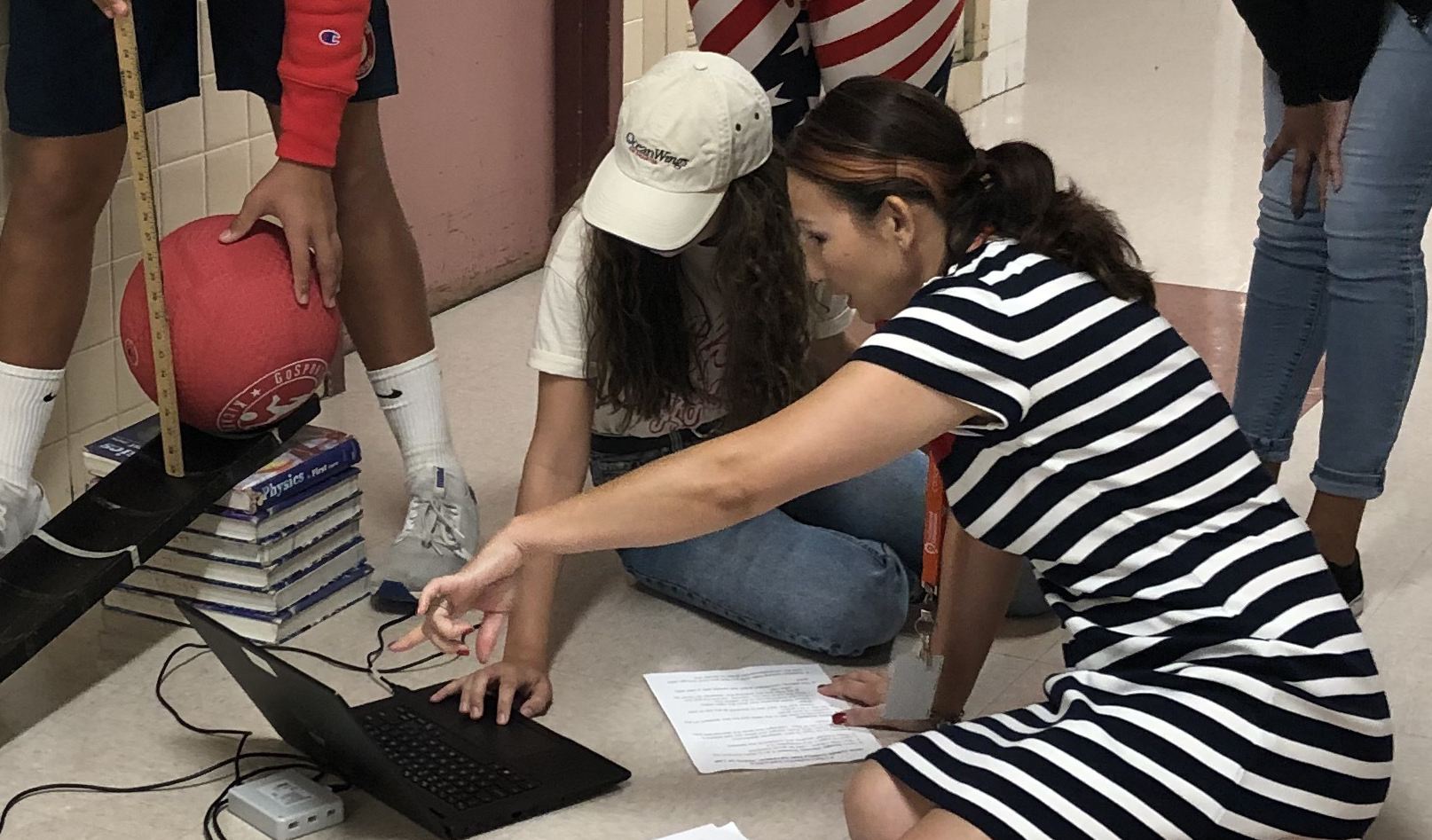
Co-author Michelle Murtha works with a lab group as they determine their experimental setup.
Conclusion
For their final, independent experiments, each group designed and tested a setup to investigate acceleration with toy cars and tracks. One group released the car from different heights down a ramp, another designed a rubber band slingshot to shoot the car along a track, the third built a Half-Atwood setup (an experiment for studying Newton’s Second Law in which a car is tied to a mass hanging over a pulley where the hanging mass is released and the car is thus accelerated down a track), and the fourth sent a car off the end of a track (cliff edge) to bounce onto a sweatshirt below while recording in slow motion with an iPhone camera to measure the speed of the drop. The physics teacher also taught the same curriculum in his other classes, where there was no co-teacher and fewer students on IEPs, yielding similar student-led project setups.
Murtha reminisces about her experience: What surprised me most was how the students could utilize CODAP on their own without the guided steps I provided. I was struck that students could tell me what the data represented. I knew they understood the concepts because they were participating in their groups and answering questions in the class without me prompting them or providing a hint of what the answer should be.
She believes that even deeper learning and more student agency for her learners will be possible next year: I’m already planning to create an experiment where the students have to graph their results in CODAP, utilizing the guiding steps and asking probing questions to get them to think about the data and what it means. This will help the students so when it is time to do experimental projects, they will have already seen CODAP and will be familiar with all the tools. My hope is that I can take away the guiding accommodations earlier in the investigations.
We also hope that other inclusion partners working with science teachers in additional districts will experience more equity of access. Having an IEP does not mean science learning is not achievable. The students in this fully-included classroom were able to appreciate the exciting and amazing world of force and motion using customized accommodations to support and scaffold their learning. As Damelin has long believed, technology can make science learning even more accessible.
Acknowledgements
This material is based upon work supported by the National Science Foundation under Grant Nos. IIS-1147621 and DRL-1621301. Any opinions, findings, and conclusions or recommendations expressed in this material are those of the author(s) and do not necessarily reflect the views of the National Science Foundation.
Sarah Haavind (shaavind@concord.org) is a senior research project manager at the Concord Consortium in Concord, Massachusetts. Michelle Murtha (murtham@portsmouthschoolsri.org) is a special education teacher at Portsmouth High School in Portsmouth, Rhode Island.
Equity Inclusion Physical Science High School



